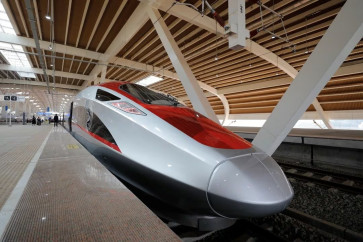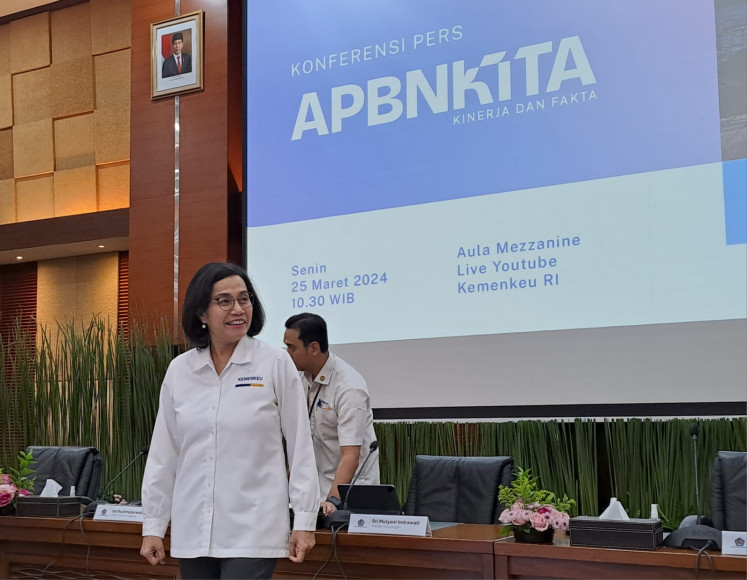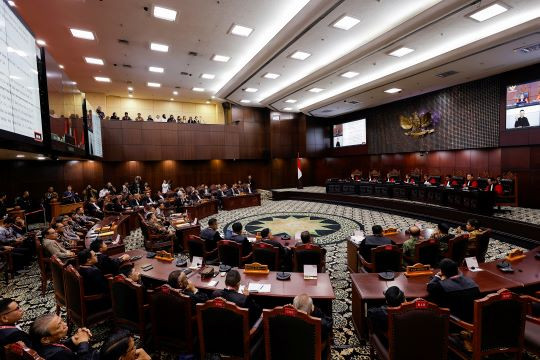Discourse: Signs of recovery are there, but not yet sustainable
Anton H
Change Size

Anton H. Gunawan and Reza Y. Siregar are two Indonesian economists, who have recently written the Survey of Recent Developments in the latest Bulletin of Indonesian Economic Studies (BIES), April 2009, published by the Australian National Univesity (ANU) in Canberra. Anton is currently chief economist at Bank Danamon and Reza is a Singapore-based analyst and previously a Faculty member at the University of Adelaide in Australia. The Jakarta Post's Manggi Habir conducted the following interview with them.
Do you see the pick up in the currency and stock market index as an indication that the worst is over and we should see signs of recovery ahead?
Reza: Indeed, the stock exchange index is often considered as a *leading indicator', and that positive trends from the index could signal a recovery in the economy's real sector. But, I won't interpret the encouraging trends that we saw as signs of a sustained recovery in the domestic economy. We presently face a global financial crisis, unlike the 1997/98 crisis.
The recovery of our economy depends heavily on sustained positive news from the global financial markets, especially from the US, Europe and Japanese markets. So far, economic indicators from these G3 economies remain fragile.
Anton: Don't be deceived by short-term and sentiment-driven phenomena. We need to take a closer look and distinguish two different parts in the economy, the financial markets and the real sector. The recent strengthening of the rupiah and the stock and bond prices were primarily driven by a swing in foreign investor sentiment towards a more optimistic stance.
There is no major change in the economic fundamentals driving financial asset prices.
What has changed is the perception of foreign investors on the Indonesian external balance, mainly the current account balance and short-term private external debt. The risks of external exposure are not as high as earlier perceived.
The current account has turned to a surplus, and there has been no strong evidence of refinancing problems for short-term private external debt. Of course, the risks are still there, but not so significant as initially perceived. Secondly, the movements of stock prices are linked to both the movements of stock prices in other countries and the prospects for the Indonesia's economy.
We understand that the worst is not over yet, although there are early signs of the economy stabilizing in China.
From your experience and our past 1997/98 Asian crisis experience, where exactly are we now in the business cycle of a recession? What are the indicators that we should be watching out for and how do we assess whether these signs show a sustainable improving trend?
Reza: We have not reached the turning stage of a recovery. Obviously, there are many more indicators to watch. But we learned from the 1997 crisis that bank lending activity is one critical indicator of any sustained recovery going forward.
Although our banks are less exposed to toxic financial derivatives, conditions remains highly sensitive to the performance of the local economy and indirectly to the global economy.
Until banks are willing to lend again, high lending rates will continue providing little support for real sector growth.
Anton: I am afraid that we are still in the downturn phase of the recession, both globally and domestically, especially if we also include the effect of the pandemic swine flu. The key thing to watch is confidence in general and across the sectors.
This can be a key driver for consumption and investment to pick up. To effectively restore confidence, we need to see the financial and capital markets functioning.
Do you feel that enough has been done in Indonesia and the region? If not, what more should be done? There was the failure of two small banks in Indonesia, which was not totally a surprise, but do you foresee more problems with the smaller banks? Is LPS sufficiently capitalized to handle potential problems?
Reza: The commitment to protect bank deposits only up to Rp2 billion was unfortunate, especially when many neighboring countries, such as Singapore, Malaysia and Hong Kong, adopted full guarantees.
Given the stronger reputation of the banking sector in Singapore, the less than full guarantee over bank deposits in Indonesia exposes local banks to a flight to quality. Yes, the concern about inadequate capital undermines the credibility of LPS.
But similar regional institutions may not have the necessary capital to cover full blown bank panics as well. So we need to exhaust all possible measures to instill confidence and to significantly reduce the likelihood of bank-runs in the first place.
Anton: Many measures to stabilize the financial sectors have been taken by the Bank Indonesia and the government, from restoring the tight rupiah liquidity situation in 4Q08, and reducing the pressure of oversupply in the government bonds market, which in turn helped reduce the pressure of "marked-to-market" valuations of banking sector assets.
Strangely enough, we saw that many depositors still did not really value the government's Rp2 billion deposit guarantee program. Many of the depositors still prefer to get higher deposit rates than settling for the maximum guarantee rate set by the Deposit Insurance Company (LPS), making them vulnerable.
The failure of the two smaller banks were not related to the global financial crisis, thus we cannot use that a measure of a bank crisis in Indonesia.
The major concern in the sector is if smaller and medium sized banks cannot cover the negative carry situation (asset yields not sufficient to cover liability costs) and the cost of rising NPLs, which is starting to happen.
How would you assess the government's stimulus package?
Reza: Weak financial systems limit the effectiveness of monetary policy. In Indonesia, Australia and UK, for instance, interest rate policy in recent months had only limited success in generating intended outcomes in the banking sector.
So fiscal policy becomes a very critical counter-cyclical measure. However, the capacity for fiscal expansion depends on the availability of financing and the level of public debt.
Finding an appropriate balance between soft (temporary employment, education and health) and hard infrastructure (roads, airports, ports, public housing and railways) projects is necessary for fiscal policy to be effective.
Anton: When we talk about the stimulus package, there are three channels that we have in mind, monetary easing (including the release of bank liquidity and declining key interest rates), declining tax revenues, and rising government spending.
Monetary easing has improved liquidity somewhat, although this has yet to translate into lower lending rates. As for the fiscal stimulus, unfortunately, a big chunk of it cannot really be classified as stimulus.
How can we include the decline of the tax revenues caused by economic downturn (lower economic growth) in the stimulus package. The late approval of the new tax laws which include the cuts in the tax rates and the readjustment of the income tax brackets, can be considered as a blessing in disguise.
The only pure stimulus comes in the form of higher fiscal spending (of around Rp13 trillion). It is just too small compared to the size of the problem; not to mention the usual problem of late spending by the government.
The concern is that a stimulus package requires substantial funding. Where is it coming from? If its government debt, which country has still sufficient room to do this without straining capacity and causing a crowding out effect hurting the private sector?
Reza: Funding from multilateral and major trading partners is critical. During the crisis, borrowing from the central bank is one effective measure to avoid *crowding out' and to minimize cost.
Close coordination between the Treasury and the Federal Reserve in the US is a good example. In addition to *cash-support', swap arrangements are also vital in guarding against potential speculative pressures on the local currency.
Anton: The government can give a stimulus by quickly implementing the PPP (public private partnership) infrastructure projects.
Just focus on removing all the obstacles of the projects implementation, and you can see the role of the private sector in stimulating the economy, such as in land clearing, additional private financing, etc.
Is there concern about inflationary consequences or is this a mute point, given the weak demand in the economy?
Reza: Sure, inflationary concerns will be the next challenge facing the monetary authorities globally. At this stage, the focus should be on economic recovery, however. Prolonged weak demand and deflationary trends should be avoided at all cost. Beside, inflationary pressure should remain moderate in 2009 and 2010.
Anton: In this kind of recession, I don't think that inflation will matter much.
There is a debate going on about relying more on the local domestic market and diversifying export markets. What are your thoughts on this?
Reza: With the meltdown in global demand, it is understandable that there is a call for a shift to rely more on domestic demand. But the trade sector will continue to be an engine of growth for Asia. Intra-regional trade, production networks and investment in Asia increased tremendously in the last decade.
We have seen the emergence of regional multi-national firms in Asia, including those based in Indonesia, but over 60 percent of their output still targets the US, Europe and Japan (the G3 market).
So the sharing of production and risks has increased among Asian corporations, but the traditional G3 markets will remain dominant in the near future. The emergence of China and India to play a more active leadership role is refreshing.
These countries have also become hubs of production networks among the Asian countries. Efforts by neighboring countries to expand their markets to rapidly growing Middle East economies have also intensified in recent years.
Furthermore, commitment on multilateral and bilateral trade and economic cooperation, especially under WTO, is becoming increasingly critical at this stage.
Anton: Indonesia was helped by its own weaknesses in this global financial crisis.
Exports are not (traditionally) as high as for neighboring countries, and we are not yet heavily involved in the Asian production networks.
Looking forward, I think we need to do everything simultaneously. The local market is important, while the external market is also important. There is also a trend towards relying less and less on the US as our main export market.









